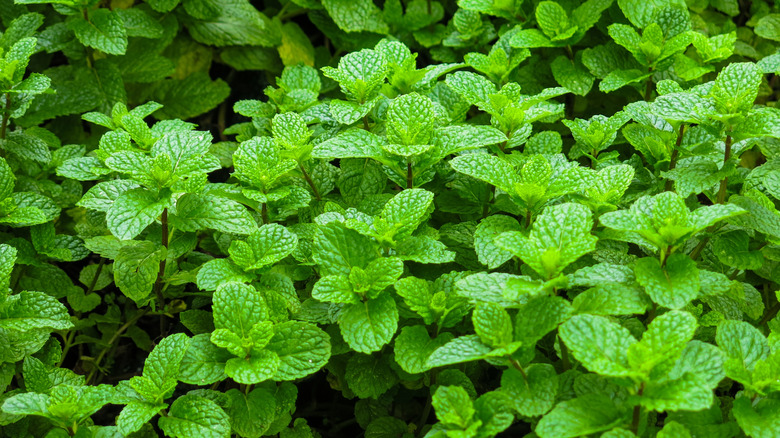Why You Should Avoid Planting Mint In Your Garden
There are a number of ways to create a home herb garden, no matter your living situation. Even in an apartment with limited space, you can still grow an indoor herb garden. Or, if you have some room outside and are a bit of a newbie, there are some great gardening tips you should learn before diving in — like don't bite off more than you can chew when it comes to the size and variety. One plant in particular that you should research before planting, though, is mint. First of all, there are many different mints, and you should learn how to pick the right type, depending on how you plan to use it. However, if you want to grow mint in your garden, you should maybe think twice.
Mint can become an invasive beast in your garden — a little creeping gremlin that will take over as much property as it can. Left to its own devices, mint can grow over your tiny sprouts, stealing their precious sunlight, or grow around mature plants and effectively strangle them. Mint grows incredibly quickly and spreads broadly via sturdy underground rhizomes. It doesn't require a lot of soil and its roots aren't very deep, so it can spread even beyond the garden if not constantly monitored. It thrives in moist, well-drained soil, so it will be even more prolific in wetter climates. And, because it's a perennial, although it may appear to die off when winter hits, the roots will still remain. At spring's return it will come back as large as it ever was.
In a word, mint is problematic. But if you're not dissuaded and are still thinking about mint in your garden, there are some ways to control it.
How to keep mint from overtaking your garden and other ways to grow it
Mint can be controlled in your garden, but because it spreads so fast, you always need to keep a watchful eye. The roots aren't very deep and can easily be pulled up. Just be sure you're removing the entire root. If you see them coming back anywhere they're unwanted in the garden, pull them up immediately. It can be a monotonous, mundane process, but you can lick them if you're persistent. Once you have the spread under control, you should choose a border — beyond which no mint is allowed to go — then pluck them weekly (or even more frequently) if they've crossed the border.
To more easily control the spread of mint when initially planting, think about planting it in a pot in the garden. You can turn the pot every week or so to keep the roots from finding purchase via the drainage holes. Mint is such a vigorous grower, it can even "escape" by growing over the pot, so pull plants up by the roots as they grow to the edge of the pot. You can even grow them in buckets or other containers with the bottom cut out and sunk into the ground. Just be sure to bury the container about 10-15 inches below the surface so that roots won't grow out from under it.
For the ultimate containment, you can even grow mint inside. A pot 12 inches deep is ideal, and they'll need at least four to six hours of sunlight a day. Keep the soil moist, but not wet. It won't be able to leave the pot, but you may still find the mint monster sneaking up on other unsuspecting plants.

